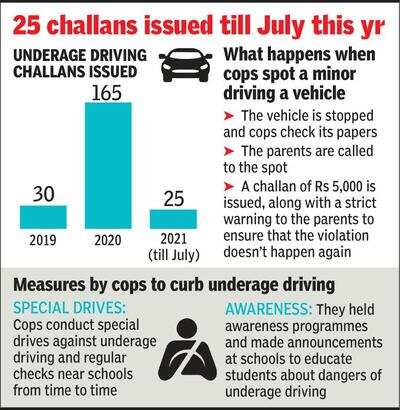- News
- City News
- gurgaon News
- Underage driving fines saw a 5-fold jump despite lockdown
Underage driving fines saw a 5-fold jump despite lockdown

Gurgaon: The city was under lockdown for most of 2020, but the deserted streets seem to have encouraged many more minors to try their hand at driving and take their cars for a spin even though they didn’t have a licence. The number of challans issued by Gurgaon traffic police for underage driving jumped more than five times in 2020 to 165, from just 30 in 2019. Till July this year, 25 challans have been issued.
Last August, finance executive Alok Gupta died in an accident near Cyber City when a Ford Ecosport being driven by a minor came out of nowhere to his side of the road and crushed him to death. The minor had apparently lost control and the SUV had jumped the central verge to crash right into Gupta, who was going to Noida on his Harley Davidson bike.
Gupta’s wife and friends have since been on a resolute campaign against underage driving and received wide support, but the challan data shows the magnitude of the challenge. The city has been intermittently under lockdown for the past two years, implying that the numbers account for only a few months in this period.
Unlike cases of traffic signal violation, underage drivers can’t be spotted through CCTV cameras. As a result, the authorities on the roads are largely responsible for detecting them. Under the provisions of the Motor Vehicles Act, in case a driver is underage, their parents who own the vehicle can be booked and fined. Meanwhile, the minor could face a trial under the Juvenile Justice Act.
Traffic police said most such minors drive their parents’ cars. “Once we identify an underage driver, we check the vehicle’s registration certificate, which is usually in their parents’ name, following which we call the parents to the spot. We usually issue a challan of Rs 5,000 with a strict warning to their parents,” said inspector Naveen Kumar, who is in charge of the challaning branch (east).
When TOI asked DCP (traffic) Ravinder Singh Tomar what measures were taken to curb underage driving in the city after Gupta’s death, he said special drives against such drivers are being conducted on a regular basis, along with routine checks at traffic junctions. “We have also increased the number of speed interceptor vehicles (which are equipped with cameras to record violators) from six to eight after the incident,” the DCP added.
Last August, finance executive Alok Gupta died in an accident near Cyber City when a Ford Ecosport being driven by a minor came out of nowhere to his side of the road and crushed him to death. The minor had apparently lost control and the SUV had jumped the central verge to crash right into Gupta, who was going to Noida on his Harley Davidson bike.
Gupta’s wife and friends have since been on a resolute campaign against underage driving and received wide support, but the challan data shows the magnitude of the challenge. The city has been intermittently under lockdown for the past two years, implying that the numbers account for only a few months in this period.
Unlike cases of traffic signal violation, underage drivers can’t be spotted through CCTV cameras. As a result, the authorities on the roads are largely responsible for detecting them. Under the provisions of the Motor Vehicles Act, in case a driver is underage, their parents who own the vehicle can be booked and fined. Meanwhile, the minor could face a trial under the Juvenile Justice Act.
Traffic police said most such minors drive their parents’ cars. “Once we identify an underage driver, we check the vehicle’s registration certificate, which is usually in their parents’ name, following which we call the parents to the spot. We usually issue a challan of Rs 5,000 with a strict warning to their parents,” said inspector Naveen Kumar, who is in charge of the challaning branch (east).
When TOI asked DCP (traffic) Ravinder Singh Tomar what measures were taken to curb underage driving in the city after Gupta’s death, he said special drives against such drivers are being conducted on a regular basis, along with routine checks at traffic junctions. “We have also increased the number of speed interceptor vehicles (which are equipped with cameras to record violators) from six to eight after the incident,” the DCP added.
FacebookTwitterLinkedinEMail
Start a Conversation
end of article
Quick Links
Delhi Air PollutionDelhi TemperatureChennai WeatherBangalore TemperatureCovid vaccination centres in DelhiCoronavirus in DelhiRTPCR test in GurgaonHyderabad RainPollution level in BangaloreDelhi SmogDelhi TemperatureNoida AQIGurgaon AQI todayFire in MumbaiMumbai RainsCovid 19 RT PCR Test in NoidaDelhi AQI todaySrinagar encounter

